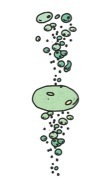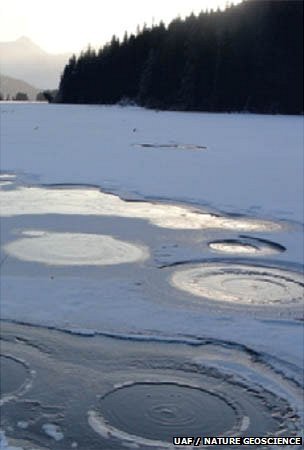And the big story this week is…..
 THE GREEK DEBT crisis, perhaps, with the Euro in perilous jeopardy? The deteriorating relationship between Pakistan and the West that threatens NATO’s mission in Afghanistan. Or, perhaps, Iran’s continued efforts to build a nuclear bomb?
THE GREEK DEBT crisis, perhaps, with the Euro in perilous jeopardy? The deteriorating relationship between Pakistan and the West that threatens NATO’s mission in Afghanistan. Or, perhaps, Iran’s continued efforts to build a nuclear bomb?
All of them seem pretty enormous, as stories go. But, to my mind, there is another story that broke to the surface this week that’s far, far, far bigger than all the others put together. In fact, this is the story that’s set to become the biggest story in the whole of human history.
In case you didn’t already know, gargantuan bubbles of deadly methane gas are bursting through the Arctic ocean and they threaten to engulf the whole world in a climactic apocalypse that even the most salacious tabloid newspaper couldn’t possibly over sensationalise.
And yet, apart from Richard Black, the environment correspondent of the BBC, few news outlets have given it much attention at all.
I guess that’s because few people, news editors included, have studied what I call Big History – most of us are hopeless at seeing the big picture. We were never taught that way. Our constant zooming in fragments knowledge in such a way that we mistake small parochial sagas as vitally important, while missing the giant stories that threaten our very survival.
Life on Earth has suffered at least five mass extinctions – dramatic episodes where a majority of species on earth have been wiped out in a relative short space of time. The third mass extinction, the worst of all, is thought to have annihilated as many as 96% of all species about 251 million years ago – at the boundary between what is known as the Permian and Triassic periods (so as to help your chronology, the dinosaurs first appeared about 20 million years later).
So profound was this event that even coal-making died out. There simply weren’t enough trees around to fall onto the ground and be buried in swamps to make deposits of coal. The coal gap – a 20 million year absence of coal in the rocks dating to between 250 and 230 million years ago, tells the tale of murder most foul – life’s closest ever brush with annihilation.
So what caused this ecological catastrophe?
Scientists are fairly sure they know. A relatively fast change in global temperatures (perhaps initiated by a super-volcanic eruption that spewed out gazillions of tons of global warming carbon dioxide into the atmosphere) triggered the release of frozen methane on the sea floor. As giant plumes of this greenhouse gas (ten times more warming than carbon dioxide) bubbled to the surface of the oceans a feedback loop kicked in, making the world hotter and hotter, leading to more and more methane release.
Worse was to come. When such quantities of methane mingled with the atmosphere, it reacted with the air’s freely available oxygen to produce carbon dioxide and water. As a result, oxygen levels 251 million years ago are thought to have plummeted to as low as 12% (instead of 21% today). So what rising sea levels, droughts and desertification couldn’t do to annihilate life, anoxic air-levels finished off.
Just look at these pictures.
 You can clearly see massive plumes of methane gas bursting through the Arctic Ocean, the repository of most of the world’s vast stores of frozen methane. According to this week’s journal Nature Geoscience, more than 150,000 methane plumes have so far been identified in an arc stretching from Alaska to Greenland.
You can clearly see massive plumes of methane gas bursting through the Arctic Ocean, the repository of most of the world’s vast stores of frozen methane. According to this week’s journal Nature Geoscience, more than 150,000 methane plumes have so far been identified in an arc stretching from Alaska to Greenland.
This is big news indeed. Look back in 50 years and I wage that Greece’s trifles with the Euro, Pakistan’s dalliance with the US and Iran’s bellicose ambitions will all have been long forgotten in a world in the grip of a massive ecological apocalypse with humanity, despite (or rather because of) its scientific libido, unable to turn back the clock.



